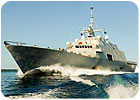
When underwater or out in space, it is comforting to know that you have the very best equipment. Along with a host of other products, Lockheed Martin produces maritime systems and sensors, and is well aware of the importance of safety and quality. Use in outer space or underwater leaves little room for error or replacement parts. Regardless of the product’s final destination, Lockheed Martin ensures that the product will work.
They take their work seriously and employees like working at Lockheed Martin’s MS2 business unit in Oldsmar, FL. After someone is hired, they never seem to leave. Besides the palm trees and weather-with average temperatures in the sunny 70s, it is arguably more pleasant than the Eagan, MN, partner business center location-it seems that there is something about the place that makes people eager to work there and proud to stay.
The weather is not the only reason. A culture of operating excellence permeates the global company.
Managers easily listed several employees who had retired after some 40 years, having been there for 20 or 30 years themselves. Despite his white hair, John Hartzel, quality assurance engineering manager of quality and mission success, says he is just a baby in Lockheed Martin time, where having decades of experience is the norm.
And the employees are good at what they do. Along with happy employees, Lockheed also seems to have happy customers. A corporate motto, “We never forget who we’re working for,” is taken to heart.

Source: Lockheed Martin
On the Floor
Despite the presence of a government inspector and a customer audit on-site, six managers made time to show a Quality Magazine editor around, providing a glimpse of what the plant looked like this summer. The tour may vary six or nine months from now, as the plant floor is a work in progress.The plant, which offers signal processors to Navy ships for circuit card assembly, has a broad range of specification compliance. While success involves several different components, the LM21 Operating Excellence program is definitely a factor. The program, started in 1998, stands for Lockheed Martin 21st Century, and is a combination of the Toyota production system, lean and Six Sigma.
Craig Mackiewicz, senior manager of manufacturing for the Clearwater operation, starts the tour. Low volume, high mix is the phrase of the day, as several applications involve this sort of process.
One of the first machines has inspection capability built-in. Inspecting these products, which look like a fleck of pepper, is no small feat. Automated Optical Inspection (AOI) compares known good parts to new parts, and will flag potential areas of concern. Because the parts are still pre-solder, this saves time and money in rework.
Because many of Lockheed’s products will go on to “fly or float,” protective coatings often are necessary, which may include sprays, dips or vacuum deposits.
On the plant floor, there are several poster board displays describing where the parts are used. While measuring and producing tiny pepper-sized flecks may not seem life or death, it is once operators consider the stakes of a failed system.
Working indoors under bright fluorescent lighting, it could be easy to forget that these systems will head to literally the ends of the earth and beyond. Submarines, space stations and military locations do not allow room for error. Unlike making ordinary consumer products, their products have to work 100% of the time, with zero tolerance for failure. “It’s different than making toothpaste,” one employee points out.
Of course, as further motivation for a job well done, many of the operators have family members in the armed forces that are using their products in the field.
However, as the tour continues, it becomes apparent that Lockheed Martin isn’t all advanced technology and military might-they also maintain the 286 computers used by the United States Postal Service. A call center is open when the first post office opens on the East Coast and when the last one closes in Hawaii. Of course, the post office product tolerances are understandably lower.
The plant itself is noteworthy for its cleanliness and efficiency. Employees, some wearing blue smocks for working in an electrostatic discharge (ESD) high-accuracy area, follow work instructions on their computers. While some employees-male and female-wear shorts with their smocks, their informal attire belies a serious attention to detail. The system has been designed to be mistake-proof as much as possible. And the system seems to be working, not only at Clearwater, but around the world.

The plant is noteworthy for its cleanliness and efficiency. Source: Lockheed Martin
Background
The Oldsmar facility is only one of many successful Lockheed Martin locations. The company, headquartered in Bethesda, MD, has 1,000 facilities in 500 cities and 46 states throughout the United States. Internationally, it has business locations in 75 nations and territories. While it is a household name, there are a few things that you might not know about the company.Lockheed Martin’s business areas include aeronautics, space systems, information systems and global services, and electronic systems. The Maritime Systems and Sensors (MS2) operations fall in the electronic systems category, which is further divided into a line of business called Tactical Systems. The Eagan, MN, facility is the business center for this division, while the Oldsmar facility is the production center. MS2 includes surface, air and undersea applications on more than 460 programs for U.S. military and international customers. Obviously, it is a busy place. But with all of these projects and programs, quality and safety are never compromised.
The Tactical Systems business began working in this 212,000-square-foot facility in 1974. It is ISO 9001: 2000 and 14001 certified, along with AS 9100. In keeping with its aim to improve an already sound safety program, the company also became a star site in the OSHA Voluntary Protection Program.
The facility is also a Boeing “silver preferred supplier” since 2003 and a Northrop Grumman “platinum source preferred” awardee.
Besides these supplier awards, Lockheed also has been recognized for its community involvement, which spans a range of projects, including INROADS, a program to provide access to minority students. And while many employees stay their entire working career at Lockheed Martin, the company also is involved with several programs to develop the next generation of technical leaders.

Each staff member contributes to the organization’s success. Source: Lockheed Martin
Get the Job Done Safely
Safety is a priority whether the company is producing for NASA requirements or 286 computer upgrades for the Postal Service. It starts the moment a truck pulls up at the dock to deliver materials. A hook grabs the back of the truck to ensure that everything is secure. Employees document everything that is received the day it arrives, so there is no dock backlog. “Swim lanes” on the floor-signs and taped areas to indicate where shipments should go-help organize products as the result of employee suggestions at a LM21 event.As products are received, it is the start of a quality focus and strict lot control. This is imperative for the company. “We know where our products go,” says Materials Manager Matthew Spear. “The products have to work every time.”
To ensure that they do, the products have barcodes, which are used as much as possible to eliminate manual data entry. The transportation totes that each product lot is put in receives a material routing report, similar to a social security number for each lot.
The tote system resembles enormous library stacks. The facility has 5,000 storage totes, with a number of configurations. Rejections are segregated, and employees say they are obsessive about accuracy.
A flat screen TV on the floor shows the operator’s screen. Throughout the floor, “dashboards” are posted to show if the project is meeting goals, with stop signs. Many are green, indicating successes, but some are red. These are looked at as an opportunity, providing a chance to look at the root cause and corrective action.
Corrective action is a big focus, and the managers review all charts and area every month. Employee suggestions to correct root cause have been implemented, including added lighting, anti-fatigue mats, new software and barcode scanning stations.
As the employees are constantly asked to raise performance levels, the posters and information make the work relevant to the big picture.
For example, before working on a shipboard network system, a pre- production Kaizen event determined that wheels on a pallet base would allow the product to be shipped on the pallet on which it was built.
Tight specifications are critical in submarine applications where connections have to be perfect, says Spear, and weight minimized in these tight spaces.
Conditions also are tightly controlled for other applications in the plant. For example, the extreme temperature and humidity chambers run functional testers to see how a product will perform in various conditions. The 18-hour cycles run from –54 C to 74 C.
Recognition
The plant has a wall displaying the Six Sigma black, green and yellow belts of the company, and highlights teams with photos and lessons learned-for example, “Do not assume that all black plastic is ESD plastic.”The company constantly solicits input from employees, discusses how to attack a problem and explains why a particular solution was chosen. Managers invite open communication, explaining that they can’t fix what they don’t know about.
While LM21 has been a success for Lockheed Martin, they are not the only ones involved in the process. Government customers participate as part of the team and some customers even have offices located in the Lockheed Martin facility.
Many people count on Lockheed Martin for products that can stand up to the elements. And because those products were made with the utmost attention and care, Lockheed Martin staff should be proud of the work they do. Whether they have been with the company for five years or 40, each staff member contributes to the organization’s success.
For more information, visit www.lockheedmartin.com.
Lockheed Martin
Lockheed Martin's MS2 Clearwater Facility
Manufacturing capabilities include:- System integration
- Electronic module and cabinet assembly
- Electromechanical assembly
- Radio frequency assembly
- Circuit card assembly
- Cable and harness assembly
- Fiber optics
- X-ray inspection
- Automated optical inspection
- Flying probe
- In-circuit testing
- Functional testing
- System test
- Environmental stress screening

